All products featured are independently chosen by us. However, SoundGuys may receive a commission on orders placed through its retail links. See our ethics statement.
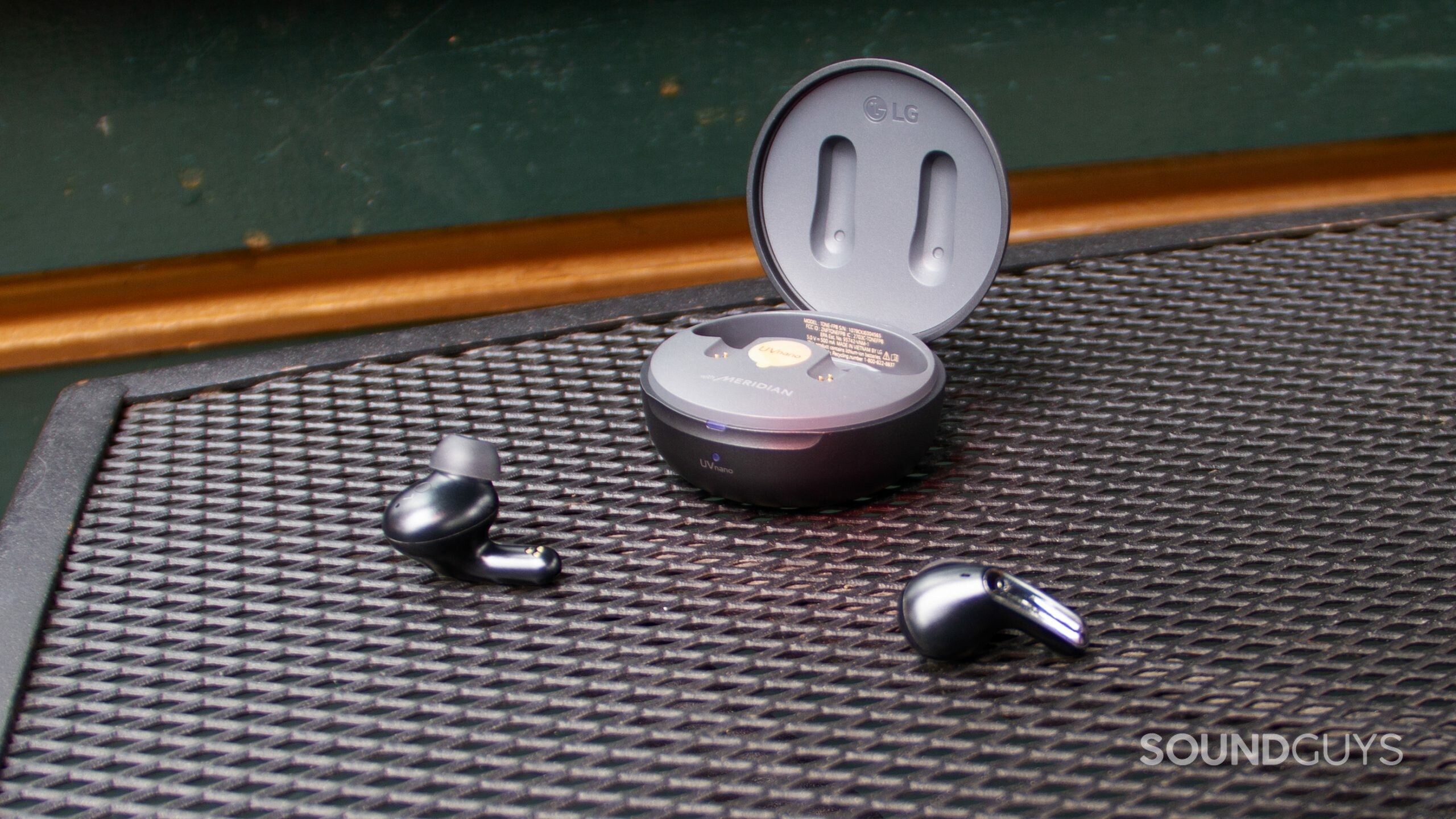
LG TONE Free FP8 review
August 31, 2022
LG TONE Free FP8
Collaborations were once relegated to the realm of streetwear and sneakerheads, but today they’re abundant. Enter the LG x Meridian Audio partnership that begets the LG TONE Free FP8 active noise canceling (ANC) true wireless earphones.
LG has almost always packed extra goodies for audio into its phones, and for some it was one of the last bastions of hope for the headphone jack’s survival on smartphones. In other words, audio is not just a tag-on feature for the company. Meanwhile, Meridian Audio is most recently known for the MQA format, but the company has decades of creating upscale audio gear.
When you take all of this into consideration, the TONE Free FP8 has some intriguing credentials. Is it just like every other pair of true wireless earbuds or does it offer something else? We spent a week with the TONE Free FP8 to find out.
Editor’s note: this LG Tone Free FP8 review was updated on May 2, 2023, to update conclusions in accordance with the LG TONE Free FP8 price drop, to add the LG TONE Free FP9, Jabra Elite 4, Sennheiser CX Plus True Wireless, and Nothing Ear (2) as alternatives, to answer an FAQ, and to update the formatting.
People looking for moderately customizable true wireless earbuds will enjoy playing around with the mobile app. Commuters who want an easy-to-use, portable set of earbuds might want to slip the TONE Free FP8 into a pocket. People concerned about sanitization can ease their anxieties (a bit) with the UVnano case.
What’s the LG TONE Free FP8 like to use?
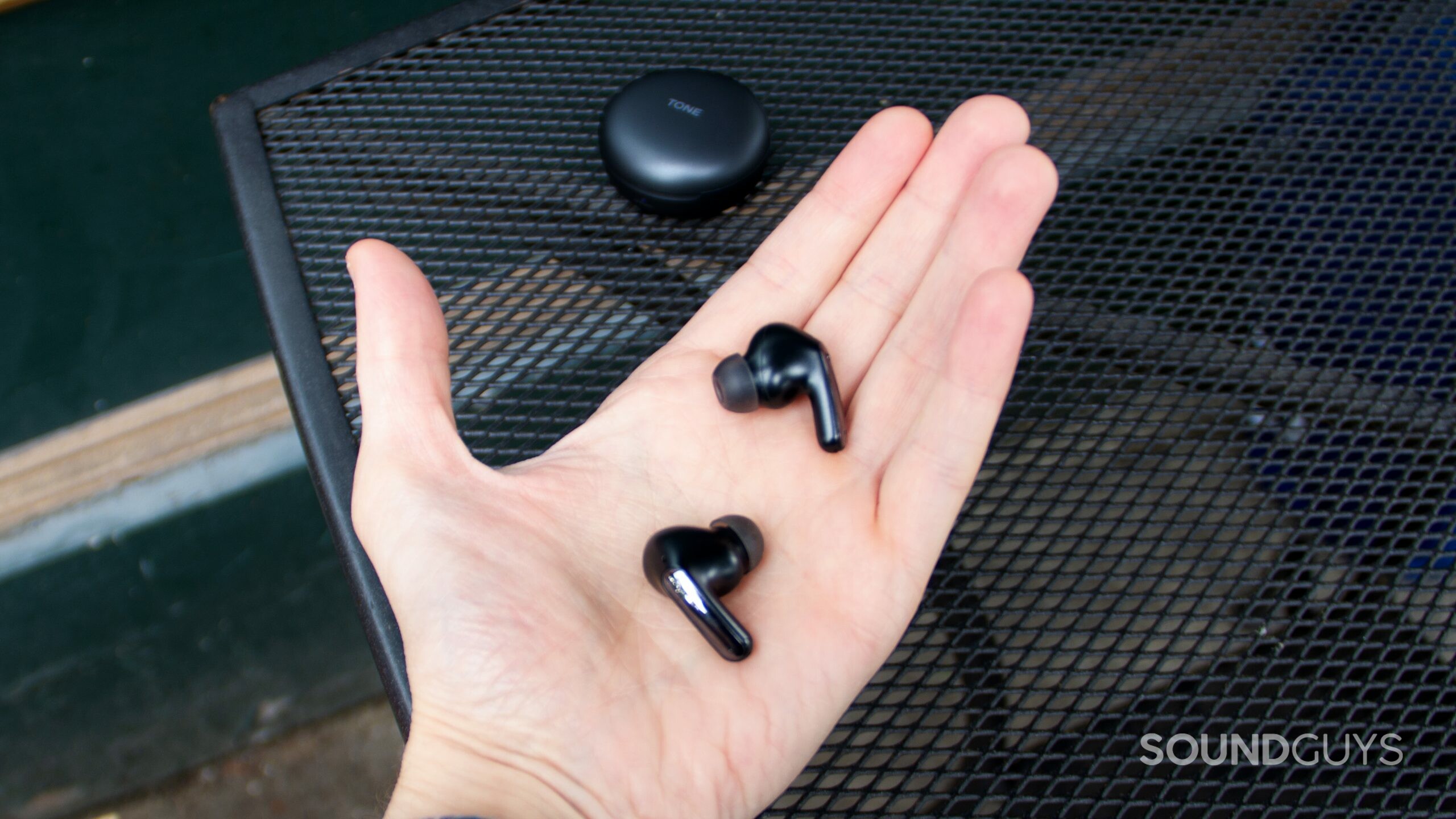
The LG TONE Free FP8 has a sort of AirPods Pro silhouette, crossed with the OnePlus Buds Pro with some of the playful jewel sheen of Samsung Galaxy Buds 2. The FP8 looks familiar, but still its own thing. Portability is the main priority, as the buds are quite light, and the case is impressively small and pocketable. Equipped with Google Fast Pair (Android 6.0+) and Swift Pairing (PC), getting connected and listening happens quickly for a Bluetooth product.
I don’t find the fit especially secure. The LG TONE Free FP8 buds don’t sit deep enough to feel locked in. With that said, the buds feel very comfortable by virtue of not fitting too tightly. You can wear these earbuds on a bus without issue, but you should avoid going for a run despite the IPX4 rating. LG provides three different size silicone ear tips, and markets them as if the hypoallergenic nature is a feature of the FP8. If you suffer from skin sensitivities, know that silicone is already hypoallergenic. Virtually any true wireless earbuds with silicone ear tips will have the same attribute.
Does LG’s UVnano case really clean your earbuds?
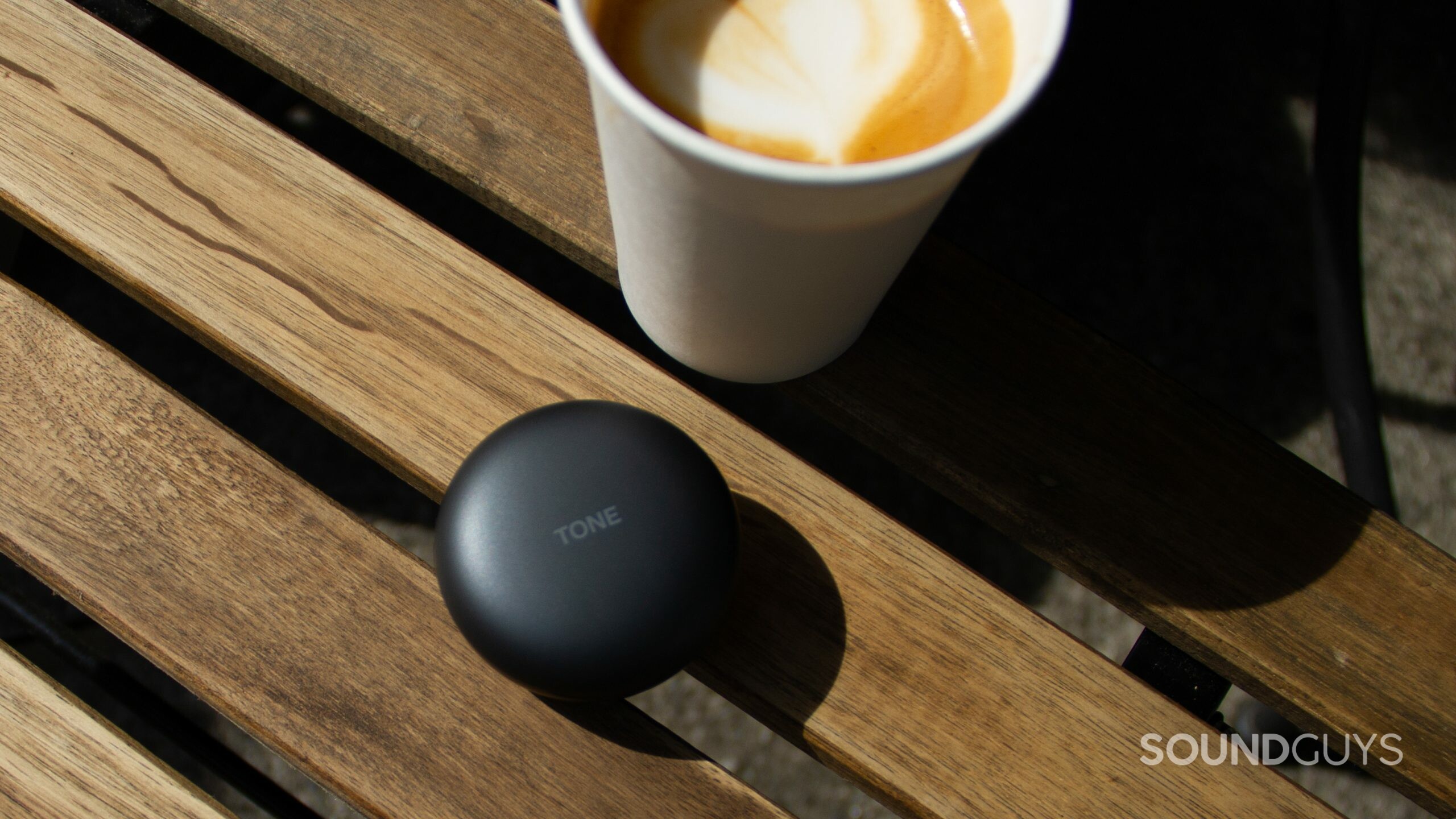
One of the selling points of the LG TONE Free FP8 is the special charging case. Its UV sanitization eliminates 99.9% of bacteria (apparently independently tested) after five minutes in the case. The caveat here is that it only works on the speaker mesh, and not the whole bud. Additionally, sanitization only works when the case itself is connected to a power source, like charging via USB-C or on a wireless charging pad. If you’re out and about and replace the buds into the case it will only charge.
I have no qualms with making fairly intimate and difficult to clean technology more sanitary, even if it seems gimmicky. If you share, it’s nice to know you won’t be picking up someone else’s ear infection. Having worked in settings where the public shared items like headphones, I welcome such developments. Make no mistake though, you still need to manually clean your buds of debris. Ultimately, the area sanitized by the case is tiny.
There are a few caveats to the FP8 case's sanitization feature.
When you open the case a helpful, pleasantly dim blue “mood light” illuminates to bring some fanfare and function to the experience. Since it’s already there, I wish the light came on when the case is empty. This would help anytime you put the buds away at night. Speaking of putting the LG TONE Free FP8 back in the case, the buds don’t always fit inside perfectly which requires you to nudge them into place. While hardly dire, even cheaper buds have managed to lock in without wiggle room for a while.
How do you control the LG TONE Free FP8?
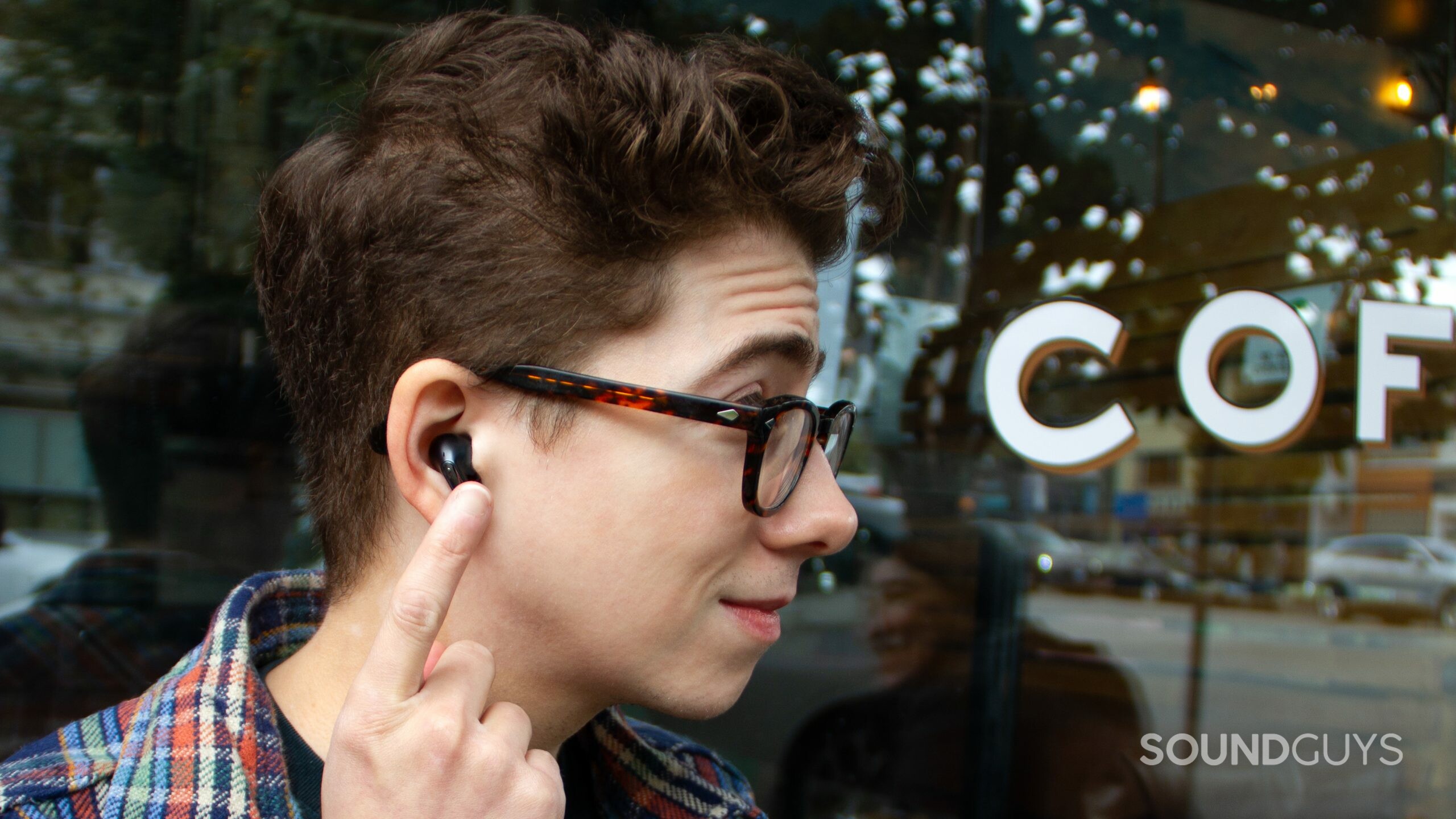
Each earbud uses touch controls that trigger a satisfying, yet subtle, click sound to indicate the tap was registered. Out of the box, it’s fairly intuitive: one tap to pause/play, two to adjust volume (louder for the right ear and quieter on the left), and three to skip forward. You can change most of these assignments in the app, more on that later.
Like many true wireless earbuds, a poor fit with the FP8 means that sometimes a command will accidentally trigger when you adjust the earbuds to remain in place. That said, the touch controls are not hypersensitive like the Samsung Galaxy Buds Pro and Galaxy Buds 2. If this happens often, change the setting in the app so that every command requires at least two taps to minimize mistakes. When intentional, the touch commands work pretty responsively. Meanwhile, auto pause/play in-ear detection generally works with ease.
Should you get the TONE Free app?
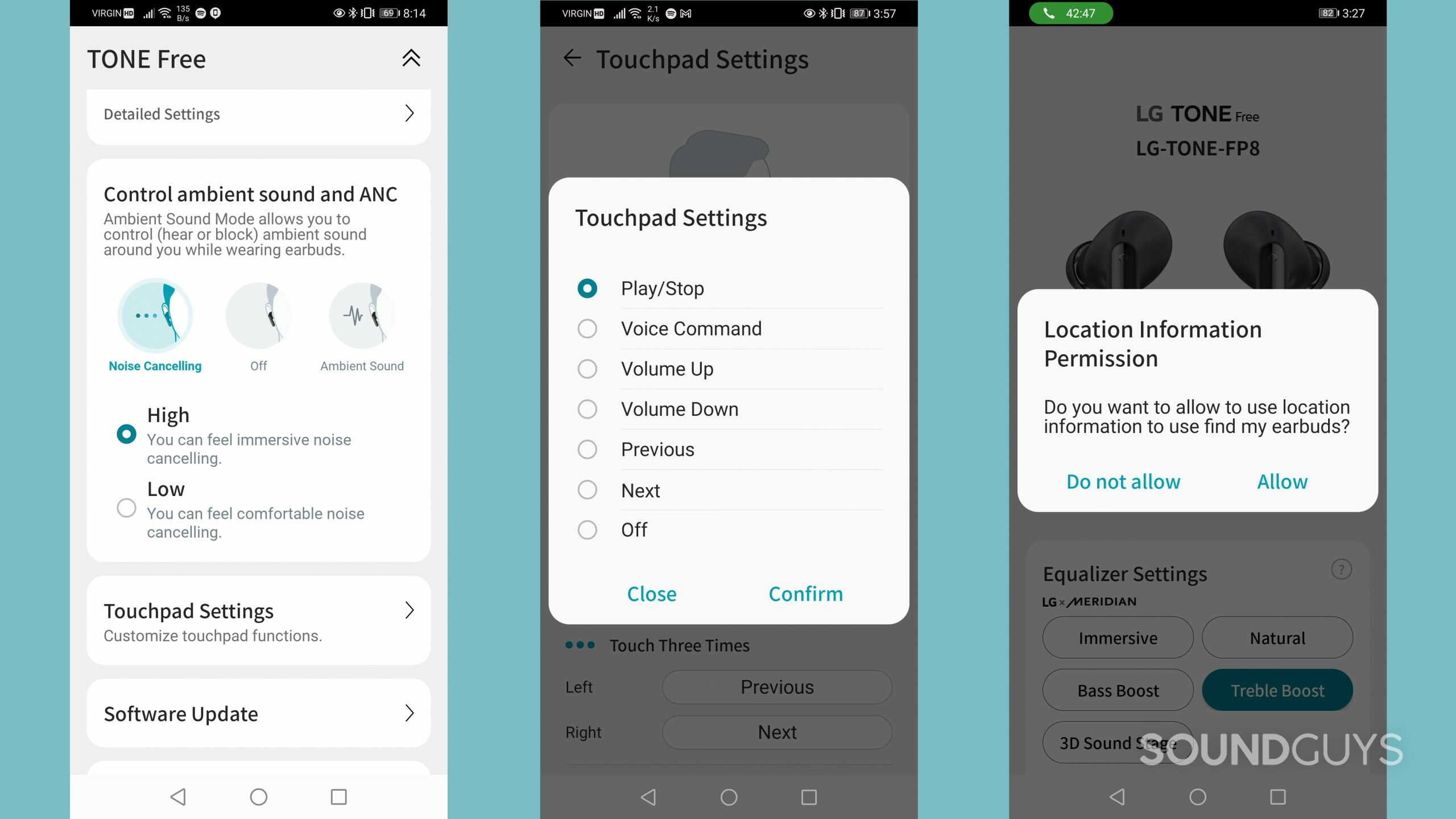
When you initially pair the LG TONE Free FP8, a pop-up card prompts you to download the app. This removes one extra barrier in streamlining the experience—no app store searches. In the app, there’s a full suite of options. You get thorough instructions on the touch controls, auto play/pause toggle, noise canceling options (high or low), in addition to Ambient mode, as well as Find my device options, and phone call touch controls. For basic things like updates, you need the app too.
In use, two issues crop up. I choose to keep Find my device off, but every single time I open the TONE Free app, it reminds me to change my settings—Take a hint, LG. Secondly, sometimes the app freezes, necessitating shutting down the app altogether and trying again. This review uses version 1.12.1.
One of the more interesting features in the TONE Free app includes EQ presets and an extra two user-created EQ settings. Unfortunately, you don’t get a visual frequency response graph of the presets, though you get descriptions. For users less familiar with frequency response charts, the descriptions offer some guidance, even if they don’t tell you much. If you create your own preset, the app shows a flat EQ that you may adjust. However, not seeing the presets represented in any visual form means making adjustments requires a little bit of blind guesswork for most folks.
How is the surround sound?
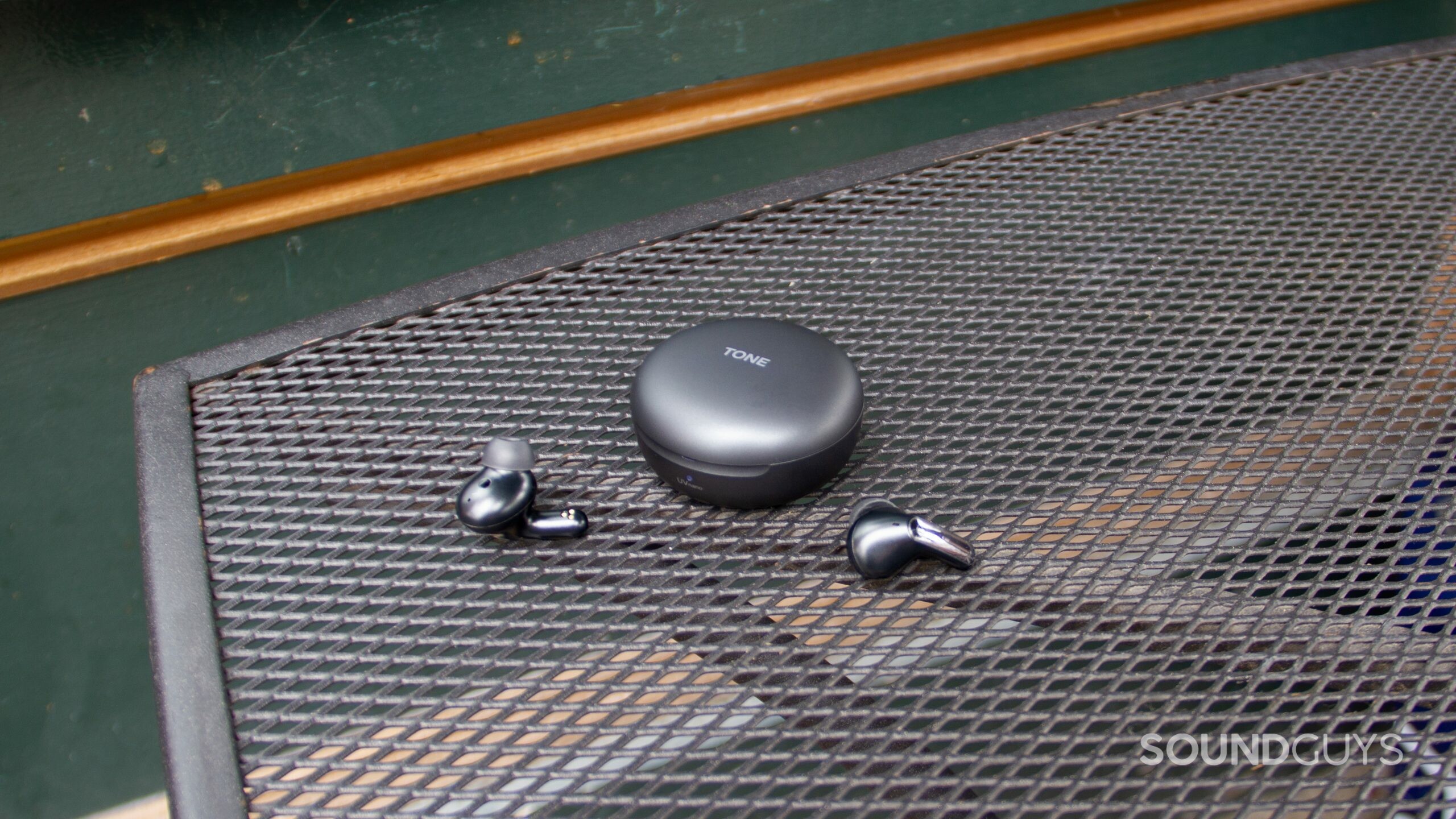
For movies or complicated music recordings, a wide soundstage or surround sound offers a more immersive experience. Put on a podcast, and you may desire a narrow soundstage, so you can focus on the hosts. LG and Meridian Audio supply a single surround sound preset. The 3D Sound Stage EQ has some inter-channel (left to right and right to left) driver crosstalk simulating a true (as in many speakers) surround sound system. I only wish the EQ was adjustable while maintaining the surround sound. Because the bass emphasis of the 3D Sound Stage preset overwhelms other frequencies. In all, it is not super useful.
While Apple and Samsung have versions of this with Spatial Audio and 360 Audio, the OS, device, and streaming-agnostic nature of the FP8 is refreshing. Mind you, it is less technologically impressive, because it doesn’t use anything like Dolby Atmos or head tracking. That said, as a listener using any particular device or service won’t hamstring you. Kudos to LG here for the baby step, let’s just hope this capability gets expanded.
You don’t need surround sound to enjoy the vast majority of music out there. Music has been mixed in stereo almost exclusively since the mid 1960’s. Surround sound is a fun bonus, and where available, an immersive way to watch movies on your phone or tablet, but it’s pretty limited in use. In addition, not every platform or manufacturer has agreed on a standard platform, though Dolby Atmos gets close.
How do you connect the LG TONE FP8?
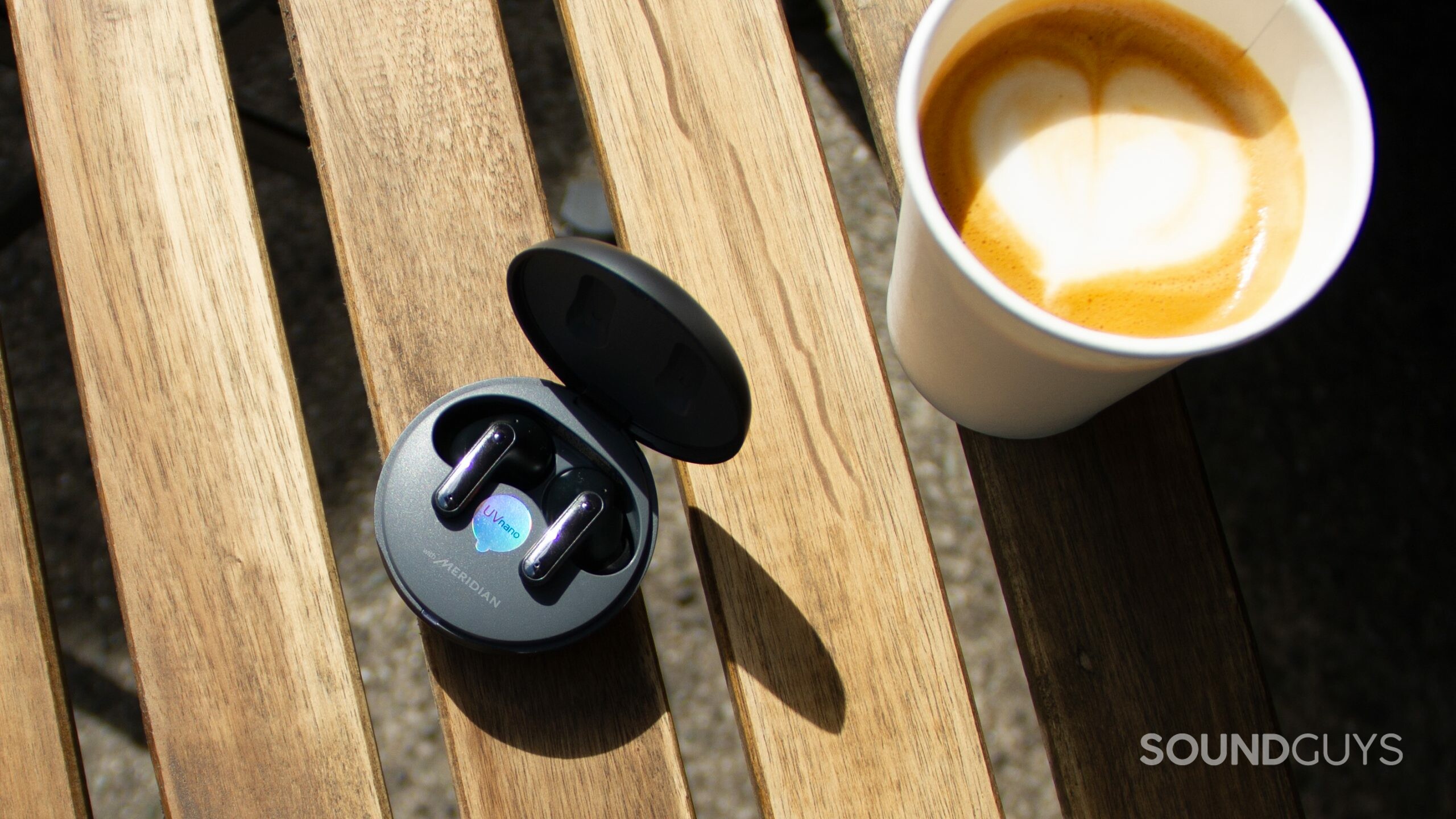
No matter the operating system, the LG TONE Free FP8 remains connected to a phone well over seven meters. You get the basic AAC and SBC options with the LG TONE Free FP8, which is equipped with Bluetooth 5.2. iPhone users should stick to AAC for best results, while some Android users will notice a more consistent connection using SBC.
The TONE Free app has a specific EQ preset called 3D Sound Stage, which is geared more toward video content. Over AAC and also SBC, using an Android device, I can barely detect any latency with video streaming. If I look for it, I can find some delay, but not enough to affect the viewing experience negatively. However, bothering to make an EQ preset for video really makes me think an even lower latency codec, like aptX Adaptive could have made it better.
The TONE Free app has a TONE Free LAB section with features still in some stage of development. This includes a Game Mode, which offers lower latency at the expense of sound quality. Why not just use a lower latency codec, LG?
To pair the LG TONE Free FP8 initially, open the case and press on the left bud until the case light flashes blue, and select it under your Bluetooth settings. Under subsequent uses, it pairs automatically.
What’s the battery life like on the LG TONE Free FP8?
Five minutes in the case yields an hour of play. Wait an hour to fully charge the FP8, and two hours to fully charge the case. In our testing with ANC on the FP8 lasted 6 hours and 2 minutes, which is basically spot-on for what LG claims. This is a pretty healthy battery life for ANC wireless earbuds and a small case. Meanwhile, the case supplies an additional 15 hours of battery life (with ANC on).
The presence of LED charge indicators on the case helps. Think traffic lights: red means 20% charge or less, yellow means anywhere from 20% to 80%, and green is 80% or more. When plugged in, red is charging and green is charged—pretty basic. The blue indicator light lets you know the case is sanitizing, and blinking means Bluetooth pairing mode is on.
How good is the noise cancellation on the LG TONE Free FP8?
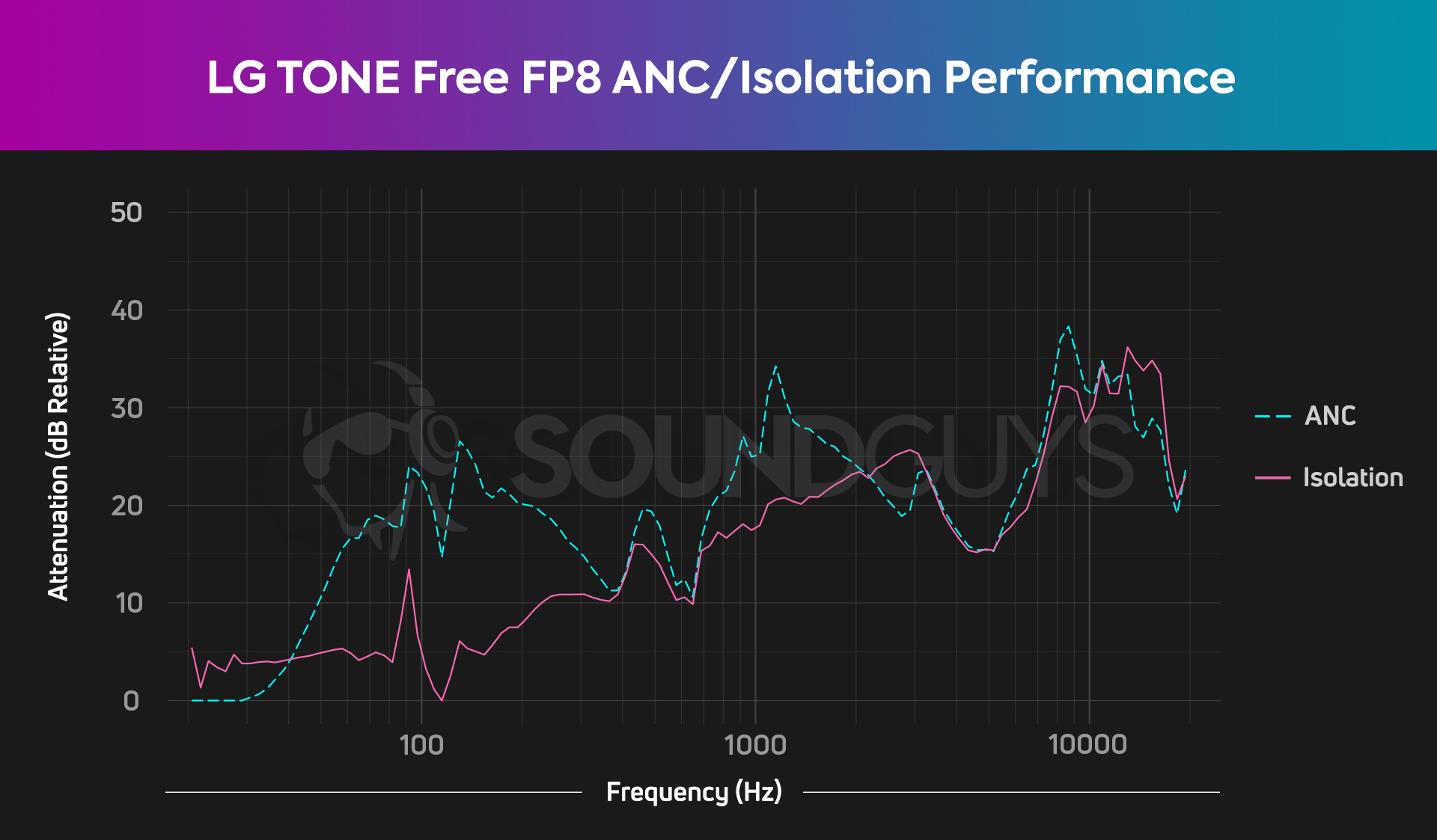
You get the options of noise Cancelling and Ambient Sound modes. Under each header are two levels of intensity to choose from. With ANC you get high and low modes, and in the Ambient Sound setting, you get Listening mode (to hear your environment) and Conversation mode.
High noise cancellation hushes my clothes dryer significantly, though occasionally some drones turn into strange new noises. If you look at the chart, you’ll see that some noises, for example around 400Hz only receive about 10dB of total attenuation, while at about 1000Hz it’s a 35dB attenuation. This means that sounds that span across a number of frequencies can end up getting reduced, but not evenly, leaving you with the occasional weird din. In any case, LG’s inclusion of a low and high setting helps individuals who want just a little bit of silence, but not total isolation. The ANC here isn’t the worst but it certainly doesn’t make it onto our list of the best noise canceling true wireless earphones either.
How does the LG TONE Free FP8 sound?
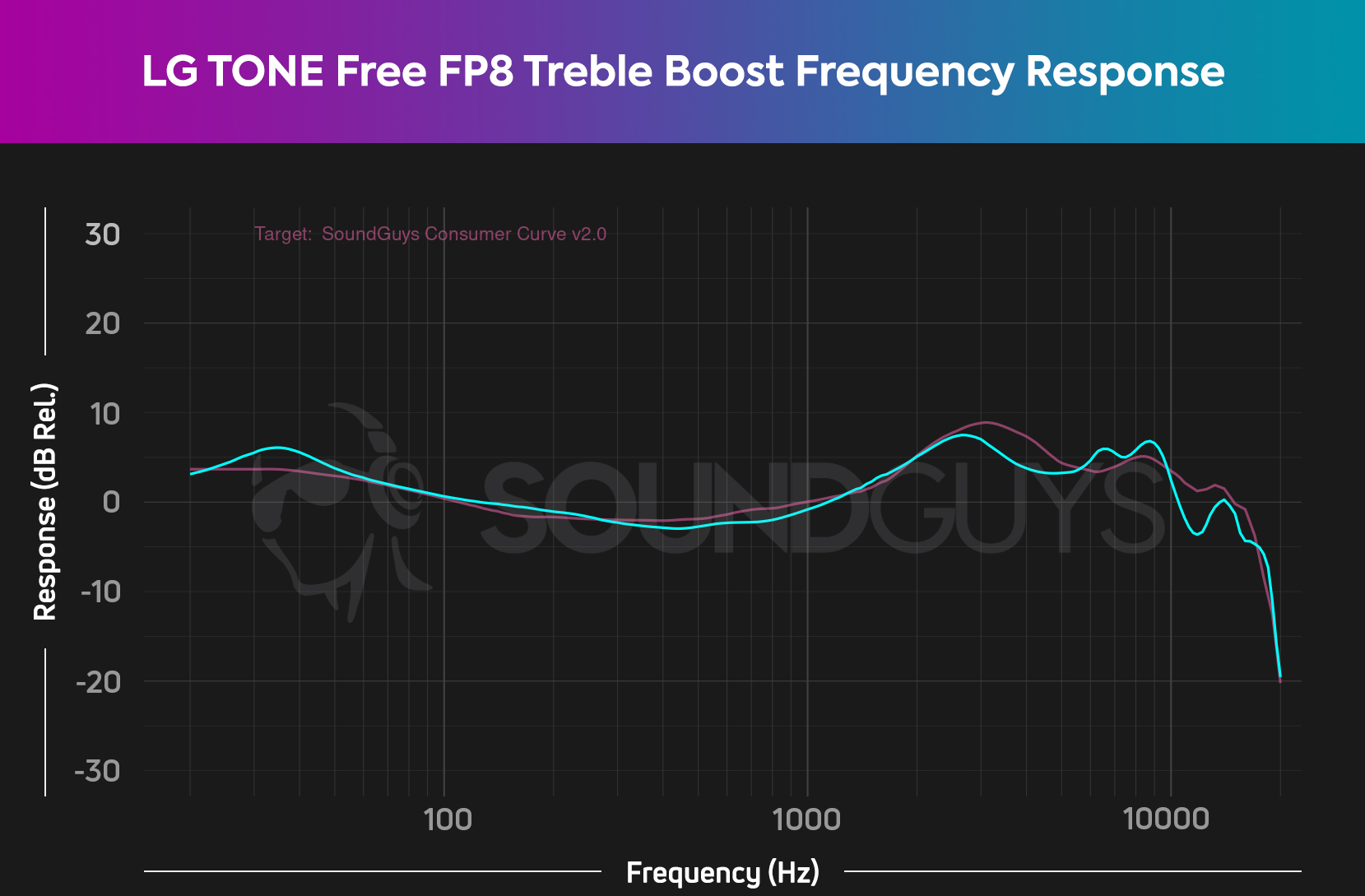
Through testing, we discovered the Treble Boost preset most closely mirrors our house frequency response. It sounds good and everything comes through loud and clear. The preset almost one-to-one matches through the bass, mids, and lower treble. The sub-bass receives a slight bump between 30-40Hz. In the highs, the EQ receives about a 5dB under-emphasis around 3kHz and again around 10kHz. Generally, this frequency response provides a fairly conservative curve, which means you’ll hear your sound source without issue.
Above is a bonus: because the presets don’t give anyone a strong sense of how LG and Meridian Audio have configured the EQ, we’ll show you what’s what. Remember the cyan curve is the FP8 and the pink is ours.
Highs, mids, lows
With the misnamed Treble Boost preset, the TONE Free FP8 manages to clearly reproduce Brett Anderson’s falsetto in No Tomorrow by Suede. Meanwhile legitimately trebly guitar, which makes up the majority of the song, does not mask the bass or drums.
The TONE Free FP8 effectively reproduces any engineered left-right pans, and yields what some may refer to as a wide soundstage for earphones. It’s easy to detect which guitar is playing. In fact, bass sounds pretty close to exactly the right relative volume, with a good amount of oomph to carry the rhythm section. Owing to the healthy decibel bump in the highs, cymbals and snare sounds cut through too. It sounds good.
Can you use the LG TONE Free FP8 for phone calls?
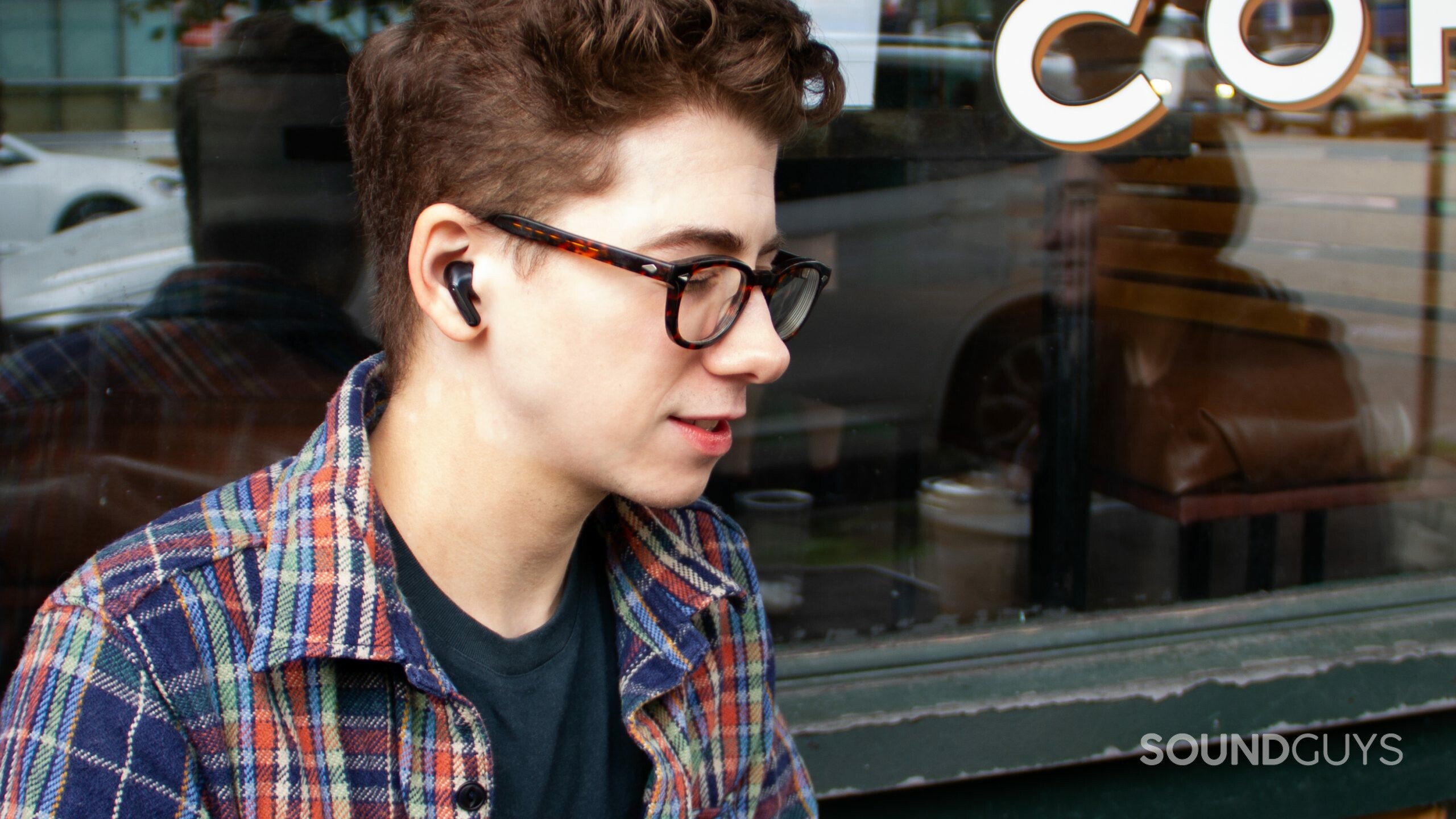
Equipped with three microphones, the LG TONE Free FP8 definitely works for phone calls. In testing, six different people hear me without issue using the FP8. The voice comes through clearly enough, however, it does not sound especially accurate, capping off treble and bass artificially.
What do you think?
LG TONE Free FP8 microphone demo (Non-standardized):
How does the microphone sound to you?
Hold up! Something’s different:
We’ve made a big improvement to how we demonstrate the microphone performance of products we review. We now use a standardized test setup that plays back pre-recorded phrases from a calibrated artificial mouth in our test chamber, either with or without simulated background noises, simulated reverberant spaces, or artificial wind. This means that samples from every product can be directly compared, which makes it far easier to make meaningful comparisons between products in terms of the raw speech quality or the product’s ability to reject noise.
These new mic demos will be made obvious in each new sample which begins with the phrase, “This is a SoundGuys standardized microphone demonstration …”
Thank you for bearing with us, and we hope to see you again once we’ve sorted everything out.
Should you buy the LG TONE Free FP8?
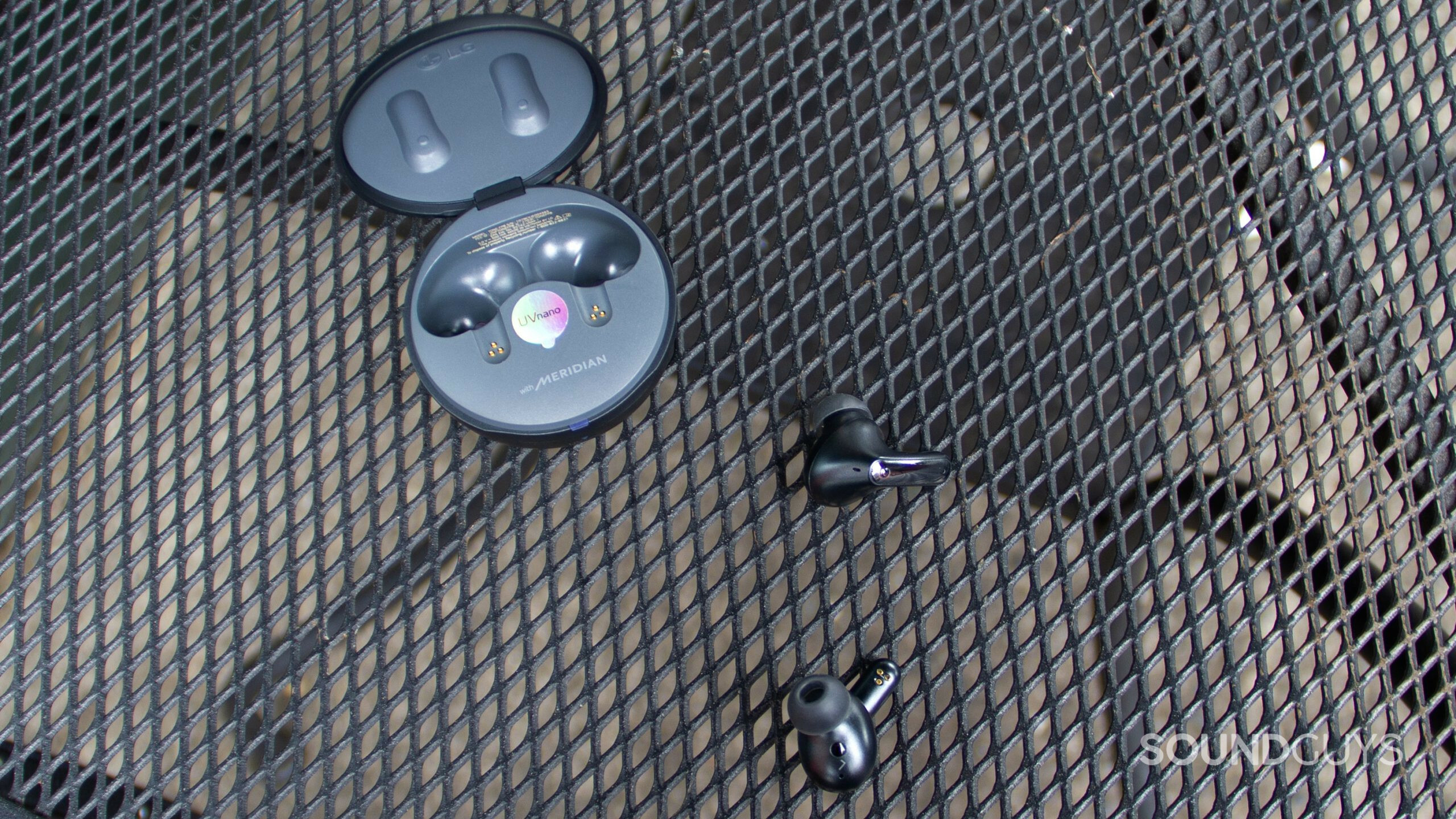
The TONE Free FP8 has so much potential with its comfortable fit and good sound quality. The stable connection and good battery life of the TONE Free FP8 promote it as a strong candidate for your collection, as does the fast pairing. However, it falls short in some regards, inspiring a wish list of improvements or features: a fix for occasional software freezes (at the time of the original review), and more surround sound options, among others. With its drop in price the FP8 is now a pretty good choice for a lot of people looking to stay under $100 USD with ANC.
Aside from the software slowdowns, let’s just agree that instead of a sanitizing gimmick that only works on a few millimeters of each earbud, maybe LG should just make a bud that’s easy to clean. Even still, some shoppers will enjoy how the case can sanitize the small grille on the earbuds, and if that’s worth it to you, happy listening. At the right price, it’s a very capable set of buds that sounds really good with the right EQ setting.

The LG TONE Free T90Q is a more premium headset, as revealed by the price ($129.99 at Amazon), but expense doesn’t equate to greatness. We like the Tone Free T90Q for its multitudinous EQ preset options, and the ability to make a custom EQ, but it falls short on the default sound profile. None of the EQ presets can get quite as close to our consumer curve as the cheaper FP8.
The ability to transmit Bluetooth audio from analog sources separates the T90Q from the FP8. That’s right, you can connect the T90Q case to a 3.5mm port, and it will then transmit that signal to the earbuds. This feature seems like a gimmick, but it can come in handy if you’re caught on a flight and don’t want to use the jet’s complimentary earbuds.
You also get Dolby Head Tracking support across devices, a first regarding wireless earbuds. When paired with Dolby Atmos content, the head tracking on the T90Q works akin to Apple Spatial Audio on AirPods.
If you don’t need a Bluetooth transmitter built into the case or Dolby Head Tracking technology, we recommend you save your money and get the FP8 instead.
What should you get instead of the LG TONE Free FP8?
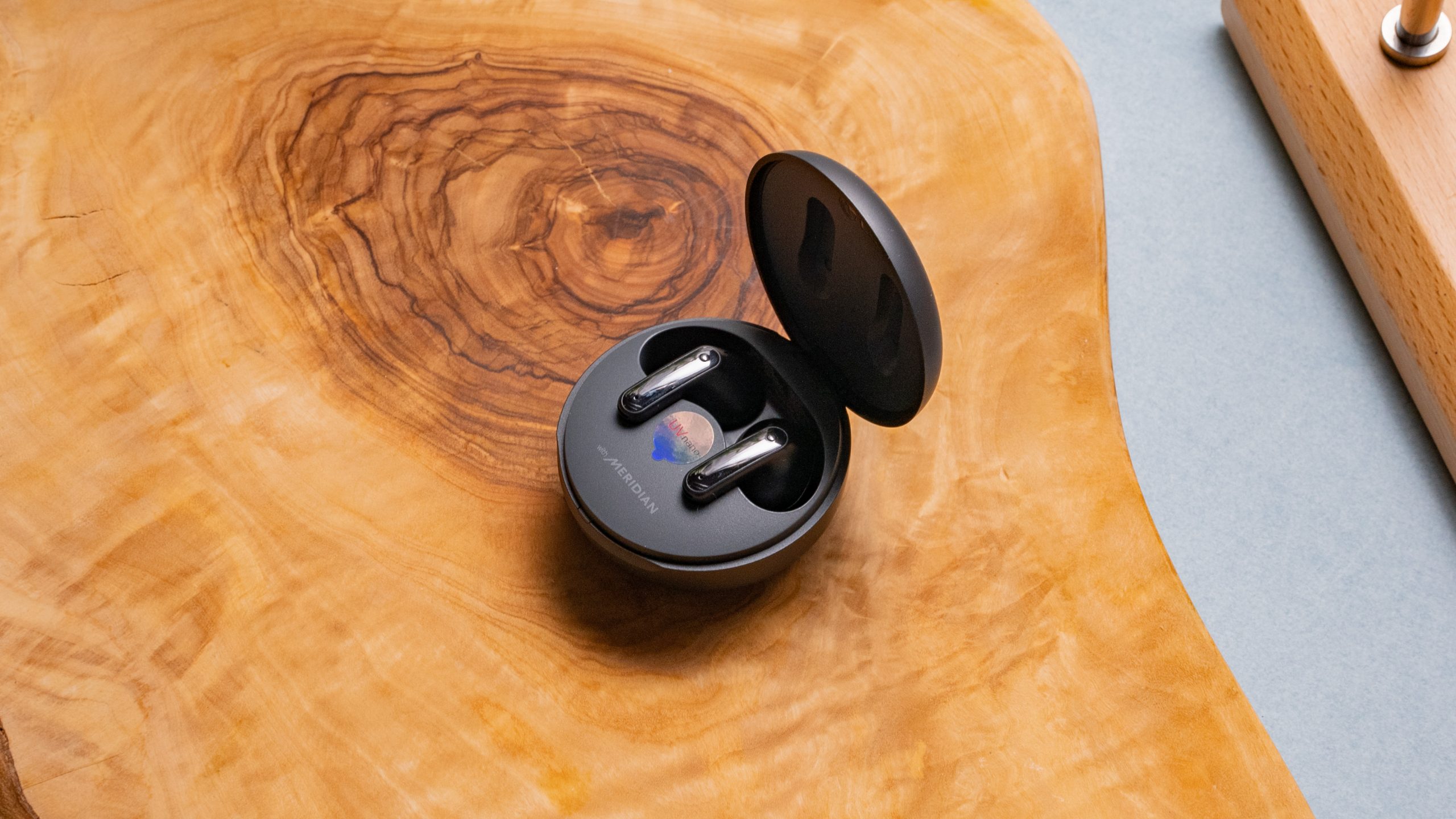
If you like to get the latest and greatest, the LG TONE Free FP8 has been surpassed by the newer LG TONE Free FP9. These earbuds are very much alike, with not only similar aesthetics, but virtually identical frequency responses, EQ presets, and noise canceling performances. It might be worth the added expense ($129 at Amazon) to go for the newer version simply to ensure longer app support from LG, depending on the price difference and availability.
Folks looking for other noise canceling capable earbuds for under $100 should take a gander at the Jabra Elite 4. Situated as a sort of middle child from the Jabra line. The Elite 4 also happens to sound decent, with solid app support. Rather than touch controls, it uses a button, and has a better IP55 rating against dust and moisture. In-ears it feels very secure compared to the LG TONE Free FP8. Interestingly, Jabra dropped the AAC codec support while adding aptX, leaving Apple users to look elsewhere.
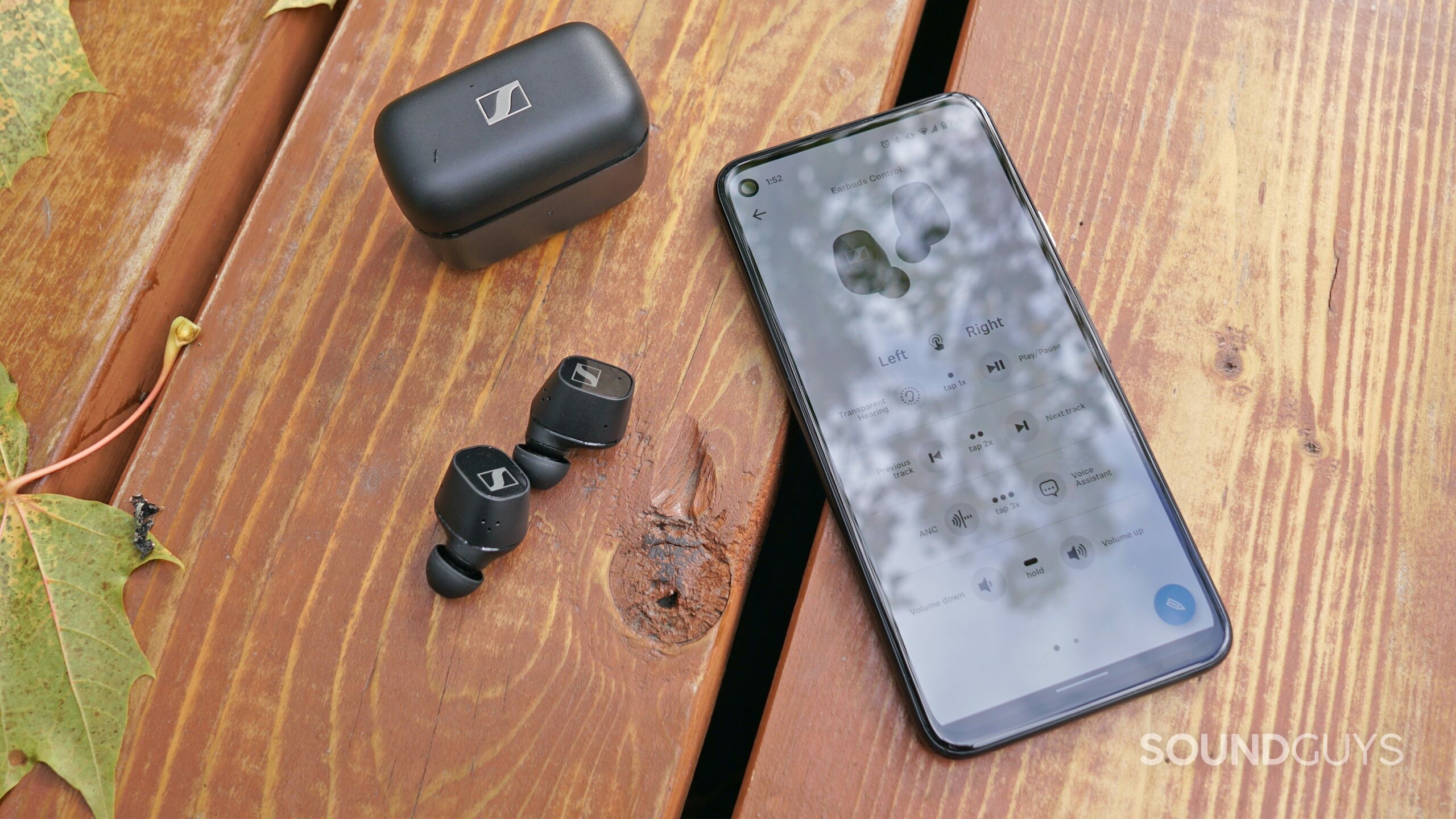
Finally, the Sennheiser CX Plus True Wireless punches above its weight class in terms of connectivity, price ($89 at Amazon) and ANC. Equipped with aptX, AAC, and SBC, it’ll please the majority of listeners with a pleasant tuning and reliable touch controls. The stemless shape of the buds might put off some users, in which case, the Nothing Ear (2) (for $149 at Amazon) with its stemmed housing might suit some better, and decent noise canceling.
Frequently asked questions about the LG TONE Free FP8
As much as we’d love a sanitizing case to mean you don’t need to clean your LG TONE Free FP8, that’s not the reality. To clean the buds you you’ll need a couple swabs, a little dish soap, and a bit of water. Don’t fully submerge the IPX4 rated buds; you can get them a bit wet as you remove the ear tips to gently swab any debris.
With the Treble Boost EQ set, the LG TONE Free FP8 sounds very good—pretty close to the AirPods Pro (2nd generation). The LG TONE Free FP8 has worse noise canceling than the 2nd generation AirPods Pro. You miss out on Apple specific functions like Spatial Audio and the H1 chip. If you want to save yourself a chunk of cash, it makes perfect sense to grab the LG instead, and ditch those Apple ecosystem features. Even if you use an iPhone, the FP8 uses AAC and Bluetooth 5.2, so your connection will be solid.
In deciding between the Samsung Galaxy Buds 2 ($99 at Amazon) and the LG TONE Free FP8, it’s important to ask do you have a Samsung device? If not, assuming you have an Android device and don’t ever plan on switching to iOS (in which case, pick the LG TONE Free FP8 for its better performance and software support with iOS), there are a couple of key considerations. First off, the Samsung Galaxy Buds 2 has better ANC, especially with low pitched noise than the LG TONE Free FP8. Secondly, the LG TONE Free FP8 has a longer battery life to a single charge, and doesn’t have hypersensitive controls like the Galaxy Buds 2.
If you have a Samsung phone, pick the Samsung buds (assuming you can make do with the touch control sensitivity). Otherwise, it’s a bit of a draw for other Android users, given that both can deliver good sound, and are pocketable. Most folks will pick up the Samsung Galaxy Buds 2, but if you just want a smattering of ANC, and you find a good deal the LG TONE Free FP8 is a decent choice with some customizability in the controls lacking on the Samsung buds. Plus the EQ in LG app does more to the sound than the variations on a theme EQ you’ll find in the Galaxy app.